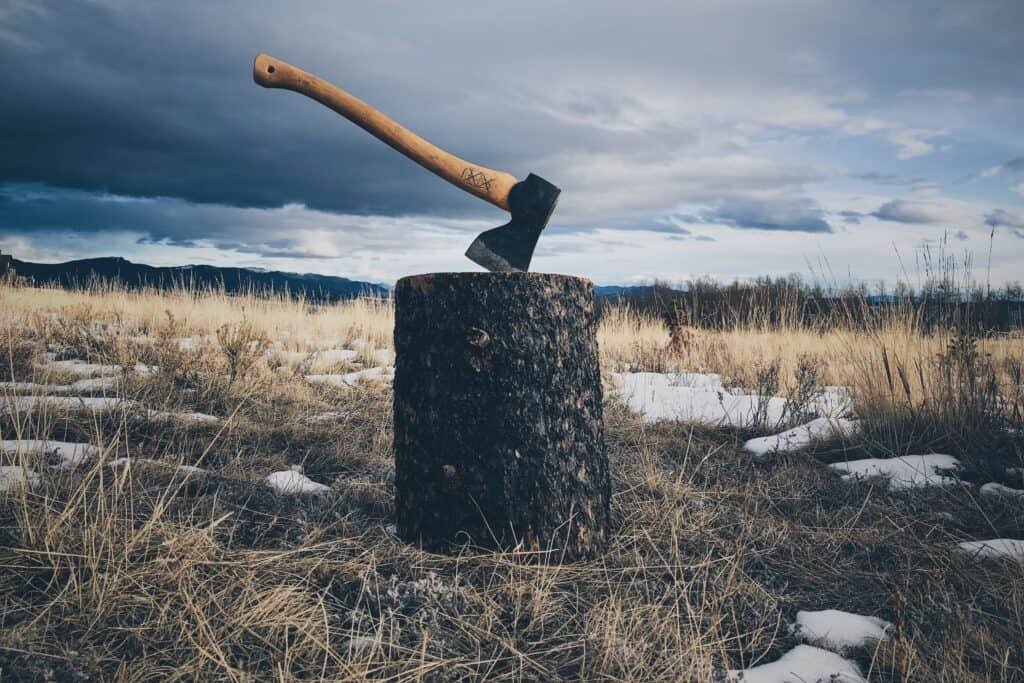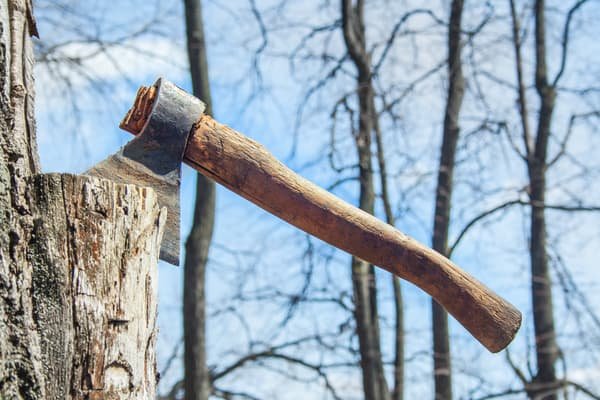Axe vs. Hatchet: Understanding the Difference in Functionality
When it comes to tackling large tasks around the home or campsite, two of the most common tools for the job are the axe and the hatchet. But what is the difference between these two pieces of equipment? What are their respective functionalities and how are they best applied?
In this article, we’ll take a deeper look at the axe and the hatchet to better understand the difference in their functionality and how they can best be used. We’ll explore the various shapes and sizes of each tool, their typical uses, and the advantages and disadvantages of each.
So if you’re wondering which tool is right for your needs, read on to understand the difference in functionality between an axe and a hatchet.
What is an Axe?
An axe is a tool used for chopping and splitting wood, and has been around since the Stone Age. It typically consists of a long handle, known as a haft, with a heavy metal head attached.
The head is typically made of steel and has a curved blade on one side and a hammer head on the other. The blade is sharpened and angled to allow it to more easily penetrate the wood and the hammer head enables the user to drive the axe into the wood with more force.
Axes come in a variety of sizes, from small hand axes to large, two-handed felling axes. Depending on the intended use, they can be either single-bitted or double-bitted, with a single blade on one side or two blades on either side of the head.
Axes are primarily used for splitting and cutting large logs for firewood or for constructing buildings or furniture. They can also be used for bushcraft activities, such as chopping down small trees or clearing brush.

What is a Hatchet?
A hatchet is a small hand-axe, typically used for chopping and splitting wood. It consists of a curved blade with a handle attached to it. The blade of a hatchet is usually much smaller than an axe and its weight and size make it easier to handle and use for smaller jobs.
Hatchets are commonly used for cutting and splitting firewood, carving, cutting branches and small logs, and for other general outdoor tasks. They are also sometimes used for hunting, fishing, or food preparation.
Hatchets are generally lighter and easier to use than traditional axes, but still require a high level of skill and sharpness to use correctly. Their blades are typically angled slightly forward, which allows them to be used in a chopping motion.
The handle is usually made of wood and can be either straight or curved, depending on the type of hatchet. The handle length also varies depending on the type of hatchet, though most are between 12 to 24 inches in length.
The weight of a hatchet also varies depending on the size and type of hatchet, with light weight hatchets typically weighing between one and two pounds.

Differences in Shape and Size
Shape and size are two key factors in understanding the difference between an axe and a hatchet. Axes typically have a longer, heavier handle than hatchets, which makes them better suited for chopping larger pieces of wood.
The blade of an axe is usually wider and flatter than a hatchet, which allows it to cut deeper. In contrast, the blade of a hatchet is usually narrower and sharper, making it better suited for carving and trimming.
A hatchet is typically smaller than an axe and is easier to wield and maneuver. This makes it ideal for finer tasks such as carving and trimming. However, because it is smaller, it is not as effective for larger tasks such as chopping large pieces of wood.
Axes on the other hand, are bigger and heavier, making them better suited for larger jobs like chopping logs. They are also more effective at splitting logs and have a longer handle, which helps the user maintain control over the tool.
Typical Uses for an Axe and a Hatchet
An axe and a hatchet are two of the most commonly used tools for tackling all kinds of tasks around the home or in a campsite. While both tools are essentially designed to chop, split, and shape wood, there are some differences in their functionality and design.
The axe is typically larger and heavier than the hatchet, with a longer handle and a larger, broad blade. It is best used for larger jobs such as splitting logs, felling trees and chopping large pieces of wood. An axe is also more effective for cutting through thicker and tougher wood.
On the other hand, a hatchet is smaller and lighter than the axe and has a shorter handle and a smaller, narrower blade. It is best used for smaller tasks such as carving, trimming branches or making kindling and notching timber. Hatchets are often more maneuverable and require less effort to use, making them great for precision work.
No matter which tool you choose, both the axe and the hatchet can be very useful for a variety of tasks. Just make sure to pick the right tool for the job and always use appropriate safety gear, such as goggles and gloves.
Advantages and Disadvantages of Each Tool
Advantages of the Axe
An axe is a powerful tool that is great for clearing brush, chopping logs, and even splitting large logs. These tools are usually larger and heavier than hatchets and can be used for heavier cutting and chopping tasks. The heavier weight of the axe gives it more force, making it better suited for tougher tasks. Additionally, the wider head of an axe means that it can cover a larger area when chopping, making it faster and more efficient.
Disadvantages of the Axe
The larger size and heavier weight of axes can make them difficult to use for smaller tasks. Additionally, since the head of an axe is heavier than that of a hatchet, it can be more difficult to control and can require more effort to use. Furthermore, the wider head of an axe can make it difficult to maneuver in tight spaces.
Advantages of the Hatchet
Hatchets are generally smaller, lighter, and more maneuverable than axes. They are well suited for smaller tasks such as splitting kindling, and the smaller head makes them better for precision work. Additionally, the lighter weight of a hatchet makes it easier to use for extended periods of time.
Disadvantages of the Hatchet
Since hatchets are smaller and lighter than axes, they lack the force and power required to complete larger tasks. Furthermore, the smaller head of a hatchet can make it less efficient for larger jobs or jobs that require a larger cutting area.
General comparison chart
| Aspect | Axe | Hatchet |
|---|---|---|
| Size | Longer handle, larger head | Shorter handle, smaller head |
| Weight | Heavier | Lighter |
| Cutting Edge | Wider and heavier | Narrower and lighter |
| Purpose | Chopping, splitting, felling large trees | Lighter work, kindling, small trees |
| Control | Requires more space, both hands | Can be used with one hand |
| Portability | Bulky and less portable | Compact and easier to carry |
| Cost | Tend to be more expensive | Typically less expensive than axes |
Which Tool is Right for Your Needs?
When it comes to tackling large tasks around the home or campsite, two of the most common tools for the job are the axe and the hatchet. But what is the difference between these two pieces of equipment?
The axe is generally larger than a hatchet, with a longer handle and a heavier head. It is designed for heavier, larger tasks such as splitting logs. The hatchet is shorter, lighter and more maneuverable. It is best suited for smaller tasks such as trimming branches or splitting kindling.
The axe is typically more difficult to use than the hatchet because of its heavier weight and longer handle. However, its heavier head and longer handle allow for greater striking force and leverage, making it the ideal tool for splitting logs.
The hatchet, while easier to use, is also less powerful and less precise. It is better suited for lighter tasks that require more finesse and control.
Ultimately, the tool that is right for you will depend on the task at hand. If you are looking for a tool for splitting large logs, then an axe is the best choice. If you need a tool for light tasks such as trimming branches or kindling, then a hatchet is the ideal tool.
You should also consider the size of the tool, as well as its overall weight, when making your decision. Whichever tool you choose, you can rest assured that it will help you get the job done.





